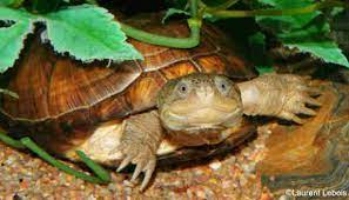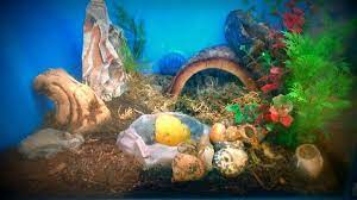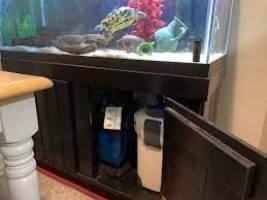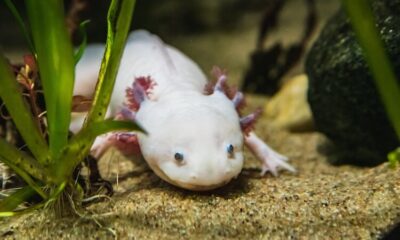Turtle
Pelusios castaneus, the African Sideneck Turtle

African sideneck turtle subspecies are not officially recognised. But because they resemble the African helmeted turtle so much, people commonly confuse the two. They are also referred to as West African mud turtles.
Due to their inability to fully retract their heads into their shells, African sidenecks instead draw their heads to the side and beneath the upper edge of their shells, earning them the nickname.
Size of an African Sideneck Turtle
African sidenecks are on the larger side of the range and can grow to be between 7 and 12 inches long as adults. Females tend to grow larger than males do. Male sidenecks can grow up to 10 inches in length at their largest.
Lifespan of an African Sideneck Turtle
African sideneck turtles can easily live for a few decades if given the right care. According to some reports, some species can survive in captivity for more than 50 years.
appearance of an African sideneck turtle
African sidenecks are typically dark in colour, and the area under their bellies, known as the plastrons, is a broad, ill-defined shade of yellow. They have two barbels (sensory organs that stick out from the lower jaw like beards), which are olive to brown in colour and have black markings on top. They have long, sharp claws or nails on lightly webbed feet. The two barbel nubs on the chin of this young African sideneck turtle are visible in the image below.
Helmeted turtle, sideneck turtle, and african mud turtle
Laurent Lebois contributed this picture to Flickr Creative Commons (click image to se larger view)
The African sideneck has a face that can be described as cute, with a mouth that is fixed into a smiling shape and big round eyes, in contrast to many turtle species that have more serious reptilian features. It seems to be playing coy when it pulls its head to the side and tucks it under its shell.
Although there aren’t any recognised subspecies, the African sideneck can exist in three different forms. The turtle has three different shell colours: the “regular form,” which is as previously described; the “rainforest form,” in which the turtle exhibits an entirely dark brown or black shell; and the “savannah form,” which has a lighter, buttery caramel hue with a fully developed yellow plastron.
Care Level for African Sideneck Turtle
West African mud turtles/sideneck turtles are best left to intermediate and experienced turtle keepers due to their environmental requirements, modest size, and long longevity. They are resilient turtles, nevertheless, and can endure starvation.
Diet of an African Sideneck Turtle
What to Feed Your African Sideneck and When
African sidenecks are omnivores in the wild and will eat anything, including local fish, vegetation, and insects. The secret to feeding your African sideneck well is diversity. No matter how much your turtle like a certain cuisine, you should always provide it a variety of foods to avoid it becoming fixated on one particular type. Don’t overfeed your turtles in addition to providing variety. Every second or third day, feed adult sidenecks as much as they can consume in a few seconds.
Insects and protein should make up the majority of your sideneck turtle’s food while it is still young and developing. They often lose the majority of their carnivorous impulses as they age.
You can give your sideneck earthworms, snails, clams, fish, aquatic insects, cooked chicken, beef hearts, crustaceans, and perhaps a few small amphibians as sources of meat proteins. Stick to nutrient-rich greens like spinach, romaine, and red-leaf lettuce for the foliage (never iceberg). Additionally, you can give your turtle chopped collard greens, weeds, and various veggies.
As aquatic turtles, sidenecks eat in their tanks, which can result in messy meals. Simply remove your turtle from its tank and feed it in a different container to avoid regular tank cleanings. To prevent food antagonism and feeding frenzies, we advise feeding many turtles one at a time as mentioned above.
Supplements
We also advise giving your turtle a calcium block or other vitamin and mineral supplements from time to time to ensure that it is getting the proper quantities of minerals.
Health of African Sideneck Turtle
Similar to other cold-blooded animals, it’s critical to meet their needs for lighting, heating, and nutrition. Other than that, African sideneck turtles are very tough animals. So, before you even bring your pet turtle home, it’s a good idea to have a reptile vet on standby. Contact your reptile veterinarian as soon as you can if you believe your West African mud turtle may be ill.
Your turtle may develop the following common ailments throughout the course of its lifetime:
Dehydration
Malnutrition
Parasites (internal and external) (internal and external)
Dehydration
Regularly weigh your turtle to keep an eye on its weight. Dehydration or an illness may be to blame for a big and unexplained weight change.
Calcium and vitamin D3 deficiency
Swollen eyes, limbs, and open skin sores are signs of vitamin D3 and/or calcium deficiency in African sideneck turtles.
Parasites
Finally, your turtle may have a parasite issue if you see little worms swimming around in its tank, if it is unable to swim or breathe properly, or if a lot of bubbles are emerging from its snout.
Behavior of African Sideneck Turtles
African sideneck turtles are hardy, energetic, of average size, and are found in large numbers in the wild. They are fantastic pets and generally little maintenance, although they may be curious nearly to the point of aggression. They can also be hostile toward one another, but this usually happens when they are eating, mating, or kept in an unclean or cramped habitat. Although they are not known for being violent toward people, if they feel anxious they might try to flee by using their claws.
African sidenecks are a terrific choice if you’re seeking for a pet that will entertain you and produce a unique presentation.
Supplies for the Environment Habitat or Aquarium Setup of the African Sideneck Turtle
African sidenecks can be kept either inside or outside, depending on the weather where you live. Only keep African sideneck turtles outside when the weather is warm because they do not hibernate seasonally like some other species.
We’ll focus primarily on indoor housing standards in this article. West African mud turtles/sidenecks just need a few things to live happily:
A tank
a dry area
Lighting
Heating
Food
As a turtle tank, you can use a variety of items, such as all-glass aquariums, sizable Rubbermaid totes, baby pools, specially made enclosures, etc.
A space measuring 6 feet by 3 feet and holding between 125 and 175 gallons of water will be adequate for a group of adult West African mud turtles. A 40-gallon glass aquarium will work just well for lone turtles.
Always choose a turtle tank that is broader rather than higher. Turtles prefer to float, dive, and bask; they don’t jump. The recommended depth of your water is between 6 and 8 inches; it should be at least 1.5 times the length of your turtle.
The one decorating item you must have is a location where your turtle can emerge from the water to dry off, preferably in the glow of a basking lamp.
You have two options for substrate: large pebbles or gravel (too big to swallow), or nothing at all. Any substrate will gather food and digestion waste, which increases the time required for cleanup.
You can either change the water regularly, such as every few days, to maintain your turtle tank clean. You may get a tank filter from your neighbourhood pet store to keep the water reasonably clean in between cleanings; just make sure it is strong enough and has a flow rate of 350 gallons per hour.
Branching and Cover
It makes sense to fill your turtle tank with items that can be found in the turtle’s natural environment. This includes driftwood, huge flat rocks (some of which should be utilised to form an above-water basking place beneath the UVB basking lamp), cork bark slabs, and vegetation in the case of the African sideneck.
Sidenecks don’t actually “climb” trees, but they can climb inclines because to their strong claws on their feet. You should provide your turtle with aquarium-safe logs and other forms of wood, but make sure you position them so that it can’t use them as a ramp to escape the tank. Otherwise, you risk having an injured turtle on your hands.
The sideneck has to be able to hide away when necessary, especially in a multi-turtle habitat where it will need to occasionally hide from other turtles that are acting aggressively. A mixture of artificial and live plants is acceptable, but make sure there are sufficient of both.
Light and Heat
An undertank heater or overhead fluorescent and incandescent lamps can be used to give lighting. To guarantee that proper temperatures are maintained, always use digital thermometers in conjunction with your lights. The water in your turtle’s tank should be between 70 and 75 degrees Fahrenheit. The ambient room temperature should remain in the low 80s while the basking area should be maintained at a temperature of 95 to 100 degrees Fahrenheit.
Not only do lights provide warmth. African sideneck turtles and other aquatic turtles also benefit from ultraviolet radiation, especially UVB rays. The vitamin D3 that these rays give turtles can keep them healthy. Remember that any plastic, plexiglass, or glass that blocks UVB/UVA lamps will stop the beneficial rays from reaching your turtle. Also, even though the bulb is still emitting light, UVB lights gradually lose their UVB intensity. Make a note on your calendar to swap out the UVB bulbs every nine months.
Your African sideneck turtle will spend a lot of time with you if you give it the right habitat and diet.
Habitat and history of the African Sideneck Turtle
The West African nations of Angola, Guinea, Ghana, Senegal, Liberia, Sierra Leone, and the Congo are home to the African sideneck. During the rainy season, they reside in rivers, lakes, and ponds. During the dry season, they bury themselves deeply in the mud (a process known as estivating). When it gets too warm, they have also been known to hibernate underground in burrows before surfacing when the weather is ideal once more.
Turtle
Discovering the Enchantment of Turtle Back Zoo

Turtle Back Zoo stands as a testament to the beauty and diversity of the natural world. Since its inception, this beloved zoo has captivated visitors with its commitment to conservation, education, and providing a home to a fascinating array of animal species. Let’s embark on a virtual journey to uncover the magic of Turtle Back Zoo.
History and Evolution
The roots of Turtle Back Zoo trace back to the early 20th century, evolving from a reptile collection in the late 1950s to the accredited zoological park it is today. Named after the nearby Turtle Back Rock, the zoo has undergone significant transformations, expanding its exhibits and facilities while prioritizing the welfare of its inhabitants.
Exhibits and Wildlife Encounters
From the majestic big cats to the playful penguins, Turtle Back Zoo offers an immersive experience for visitors of all ages. Visitors can wander through diverse habitats such as the African Adventure, where giraffes gracefully roam, or the Tropical Currents Aquarium, teeming with aquatic wonders from around the globe.
The zoo’s emphasis on conservation is evident in its efforts to house endangered species and educate the public about their plight. Encounters with Amur leopards, red pandas, and snow leopards highlight the critical need for wildlife preservation.
Educational Initiatives and Outreach
Education lies at the heart of Turtle Back Zoo’s mission. Through interactive programs, guided tours, and informative exhibits, the zoo aims to inspire a deeper appreciation for wildlife and promote conservation efforts. Schools and groups often participate in specially tailored programs that provide insights into animal behavior, habitat conservation, and environmental stewardship.
Conservation Efforts and Sustainability
Beyond its role as a recreational space, Turtle Back Zoo actively contributes to global conservation efforts. Collaborating with various organizations, the zoo participates in breeding programs for endangered species, conducts research, and supports initiatives aimed at protecting natural habitats. Additionally, the zoo prioritizes sustainable practices, implementing eco-friendly measures to reduce its environmental footprint.
Community Engagement and Events
The zoo serves as a hub for community engagement, hosting events, workshops, and seasonal celebrations. From summer concerts to Boo at the Zoo during Halloween, these events offer families a chance to connect with nature while enjoying entertaining activities. Community partnerships also play a crucial role, fostering a sense of shared responsibility for wildlife preservation.
Future Endeavors and Expansion
Looking ahead, Turtle Back Zoo continues to evolve, with plans for further expansion and enhancement of exhibits. The zoo aims to introduce new species, upgrade facilities to provide enhanced habitats, and implement cutting-edge technologies for both animal care and visitor experience.
Conclusion
Turtle Back Zoo stands as a testament to the wonders of the animal kingdom and the importance of conservation. With its dedication to education, conservation, and providing a safe haven for wildlife, this New Jersey gem offers visitors a glimpse into the beauty and diversity of our natural world while emphasizing the need for collective action in preserving it for generations to come. Whether you’re a wildlife enthusiast, a family seeking adventure, or someone passionate about conservation, Turtle Back Zoo offers a captivating experience that inspires, educates, and fosters a deeper connection to our planet’s remarkable biodiversity.
Turtle
PetSmart Crabs – The Right Way to Care For Your Pet Crabs

There are a number of things that you should keep in mind when you are looking for PetSmart crabs to purchase for your pet. Some of these factors include their cost, how long they will live for, and how to care for them. Also, you should consider the type of tank that you will use for them.
Life expectancy
When it comes to hermit crabs, PetSmart is probably the first place you think of. They are relatively inexpensive and can be fun to keep. If you want to find a store near you, you can check out their website.
Although the company has an online presence, you can usually get a good deal by visiting a local brick and mortar store. You can also take a look at their website to see if they have any special deals going on.
There are several things to consider before deciding which hermit crab to purchase. The life expectancy of your pet depends on how well you care for it. For example, a hermit crab’s life span will depend on how well you maintain its terrarium. It also requires proper ventilation, humidity, and fresh water.
Other considerations include the size of the tank you choose. The size of the tank is largely determined by how many crabs you wish to house. For instance, a 10-gallon tank will fit a couple of males and one or two females. However, a larger tank may be a better option if your crabs are aggressive.
Feeding habits
If you’re looking to buy your first pet, chances are you’ve done your research. You may have even consulted with an employee at your local pet store. They are supposed to be the role models for responsible pet care. However, what is the right way to treat your petsmart hermit crab?
There are a few tricks of the trade to keep your hermit happy and healthy. The most important is creating a home environment that will make them feel safe and secure. This means providing them with a suitable habitat with plenty of room to explore.
One of the best ways to do this is to provide them with an adequate supply of fresh water. Water temperature and salinity should be adjusted to suit your crab’s needs. Make sure to also feed your hermit a variety of fresh fruits, veggies, and grains.
Another way to ensure your pet is in good health is to provide it with a well-lit environment. While you may not want to put your hermit under the spotlight, a little natural lighting can go a long way towards ensuring your pet’s well being.
Cost of a crab tank
Red Claw Crabs are relatively easy pets to keep for beginners. They require an aquarium tank with a capacity of 10 gallons. However, you’ll also need a reliable filtration system.
Purchasing a tank with a filtration system is a necessary component of red claw crab care. It helps to keep the salinity and pH levels in check, and can help prevent any toxicity in the water.
Red Claw Crabs are sensitive to the water they live in. If the conditions in the tank are poor, they will be stressed and may even become ill.
Crabs need a lot of room to move around and to molt. They should have a tank that is about 60 cm wide. This will allow them to move easily, but also give them enough space to burrow under the substrate.
Hermit crabs need plenty of water. You should change about 10 percent of the water in your tank every week.
Appropriate tank mates for a Vampire Crab
Vampire crabs are a great addition to your aquarium. They are small creatures that are easy to care for and can be very attractive. However, it is important to keep them in the right environment so that they can thrive.
If you are considering getting a vampire crab, it is essential to understand its unique requirements. For instance, they are very sensitive to changes in water quality and temperature. Therefore, you must keep them in a clean and well-maintained tank.
The ideal tank for vampire crabs should be about 10 gallons. This will give them plenty of space to move around. Also, they prefer to live in groups.
Aside from the tank, you should also add plenty of plants. These can be of several types. You may even want to add floating plants.
In order to keep a healthy tank, you should change 40% of the water in the tank every month. You can also add a humidifier to maintain the desired level of humidity.
Turtle
8 Best Filters For Turtle Tanks

- Canister filters: These filters are powerful and efficient, and are great for larger turtle tanks.
- Power filters: These filters are easy to install and maintain, and are suitable for smaller turtle tanks.
- Underwater filters: These filters are designed to be placed inside the tank, and are great for keeping the water clean and clear.
- Hang-on-back filters: These filters are easy to install and maintain, and are suitable for both small and large turtle tanks.
- Sponge filters: These filters are simple and efficient, and are great for keeping the water clean and clear.
- Box filters: These filters are great for larger turtle tanks, and are designed to be placed outside the tank.
- Bio-filters: These filters are designed to promote the growth of beneficial bacteria, which help to keep the water clean and clear.
- UV sterilizers: These filters use ultraviolet light to kill harmful bacteria and parasites, and are great for keeping the water clean and clear.
Aquatic Turtle Filters & Pumps
are simple and efficient, and are great for keeping the water clean and clear.
Pumps:
- Submersible pumps are designed to be placed inside the tank, and are used to circulate the water and increase oxygen levels.
- External pumps are designed to be placed outside the tank, and can be used in conjunction with a filter to increase water flow and oxygenation.
- Air pumps can be used to provide additional oxygen to the water, and can also be used to power undergravel filters or create a current in the tank.
It’s important to choose the right filter and pump for your turtle tank based on the size of the tank and the number of turtles, as well as the specific needs of the species of turtle you are keeping. It’s also important to regularly maintain and clean the filter and pump to ensure they continue to function properly.
Mechanical filtration: this type of filtration uses materials such as sponge or filter pads to physically remove debris and particulate matter from the water.
Biological filtration: this type of filtration uses materials such as bio-balls or ceramic noodles to promote the growth of beneficial bacteria that break down waste products and other contaminants.
Chemical filtration: this type of filtration uses activated carbon or other chemical media to remove dissolved impurities and odors from the water.
Some filters also include a UV sterilizer, which uses ultraviolet light to kill harmful bacteria and parasites in the water.
Overall, turtle filters help to maintain a healthy environment for the turtles by keeping the water clean, clear, and free of harmful contaminants. It’s important to choose the right filter for your turtle tank based on the size of the tank and the number of turtles, as well as the specific needs of the species of turtle you are keeping.
-

 Dog2 years ago
Dog2 years agoPomeranian Dog Best Bread Information
-

 Dog2 years ago
Dog2 years agoLarge Münsterländer And Its Breed In 2022
-

 Dog2 years ago
Dog2 years agoBlue Heeler Australian Cattle Dog Breed info & Care
-

 PET2 years ago
PET2 years agoHow to choose the best pet boarding house?
-
Hedgehog2 years ago
Hedgehog Top 20 Surprising Curiosities
-

 Turtle2 years ago
Turtle2 years ago4 types of domestic turtles to have at home?
-

 Axolotl2 years ago
Axolotl2 years agoAxolotl: Top 10 Care Sheet, life & a lot
-

 Login7 months ago
Login7 months agoanimal shelters near me
